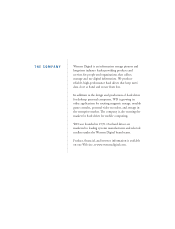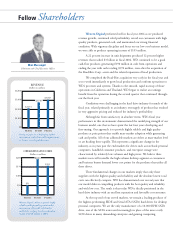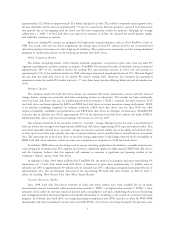Western Digital 2004 Annual Report Download - page 12
Download and view the complete annual report
Please find page 12 of the 2004 Western Digital annual report below. You can navigate through the pages in the report by either clicking on the pages listed below, or by using the keyword search tool below to find specific information within the annual report.drive, a 7200 RPM drive featuring capacities as large as 250 GB and designed for the high-end PC, workstation, server,
and external storage markets. The Company believes that SATA is also becoming a more popular interface in the
enterprise market. Western Digital currently oÅers its WD Raptor hard disk drive, a 10,000 RPM enterprise-class drive
with the SATA interface, and the WD Caviar RAID Edition hard disk drive, a 7200 RPM drive manufactured to
enterprise-class standards and available with a SATA interface. The Company is working to develop additional products
that will support these higher speed interfaces.
Storage capacity of the hard disk drive, as manufactured by Western Digital, is determined by the number of disks
and each disk's areal density, which is a measure of the amount of data that can be stored on the recording surface of the
disk. The higher the areal density, the more information can be stored on a single platter. As the areal density increases,
fewer disks and/or heads are required to achieve a given drive capacity, thus reducing product costs through reduced
component requirements.
Head technology is one of the variables aÅecting areal density. Historically, there have been rapid technological
changes, resulting in several generations of head technology in a relatively short period of time. However, in recent years
the time has lengthened between changes in generations of head technology. Currently, the desktop hard disk drive
industry uses giant magnetoresistive head technology, which allows signiÑcantly higher storage capacities than the
previously utilized thin-Ñlm head technology. All of the Company's hard disk drive product oÅerings currently employ
giant magnetoresistive head technology.
The Western Digital product line generally leverages a common platform for various products within product
families with diÅerent capacities to serve the diÅering market needs. This platform strategy results in commonality of
components across diÅerent products within product families, which reduces exposure to changes in demand, facilitates
inventory management and allows the Company to achieve lower costs through economies of scale purchasing. This
platform strategy also enables computer manufacturer customers to leverage their qualiÑcation eÅorts onto successive
product models. The Company expects to continue to utilize this platform strategy as it continues to develop products for
the emerging market for hard disk drives speciÑcally designed for audio-video applications, such as digital video
recording devices.
Constant innovations in research and development are essential to the Company's ability to compete. Hard disk
drive providers, including Western Digital, are evaluating or implementing a number of technological innovations
designed to further increase hard disk drive performance and reduce product costs.
For an additional discussion of technological innovations, see Part II, Item 7, under the heading ""Risk Factors That
May AÅect Future Results.''
Sales and Distribution
The Company sells its products globally to system manufacturers, distributors, resellers, systems integrators and
retailers. Manufacturers typically purchase components such as hard disk drives and assemble them into the computer
systems they build. Distributors typically sell the Company's drives to small computer manufacturers, dealers, systems
integrators and other resellers.
Original Equipment Manufacturers (""OEMs''). Sales to OEMs accounted for 51%, 52%, and 54% of the
Company's revenue in 2004, 2003 and 2002, respectively. During 2004, the Company's major OEM customers included
Dell, Fujitsu, Gateway (including sales to E-Machines prior to its acquisition by Gateway in March 2004), Hewlett-
Packard and IBM. Typically, revenue from sales to certain OEMs account for more than 10% of the Company's revenue.
For example, during 2004, sales to Dell accounted for 14% of the Company's revenue. During 2003, sales to Dell and
Hewlett-Packard (including sales to Compaq Computer after its merger with Hewlett-Packard in 2002) accounted for
20% and 13% of revenue, respectively. During 2002, sales to Dell and Hewlett-Packard (including sales to Compaq
computer prior to its merger with Hewlett-Packard in 2002) accounted for 15% and 13% of revenue, respectively. The
Company believes that its success depends on its ability to maintain and improve its strong relationships with the leading
computer manufacturers. Since 2000, Seagate Technology, Western Digital, and Maxtor (which merged with Quantum
in 2000) have had the highest market share with these manufacturers.
System manufacturers evaluate and select their hard disk drive suppliers based on a number of factors, including
overall quality and reliability, storage capacities, performance characteristics, price, service and support, ease of doing
7
























